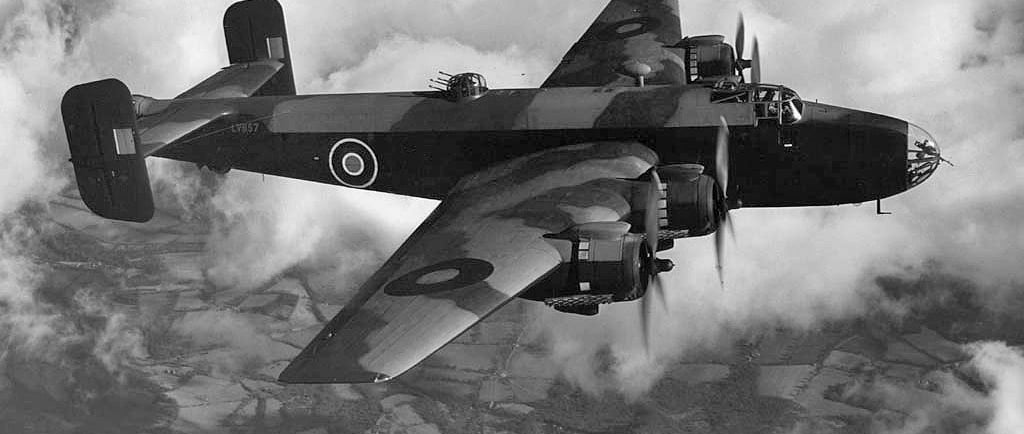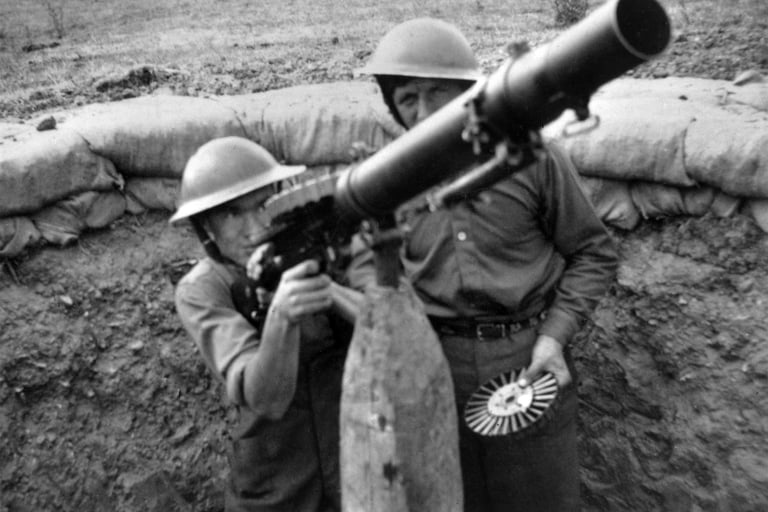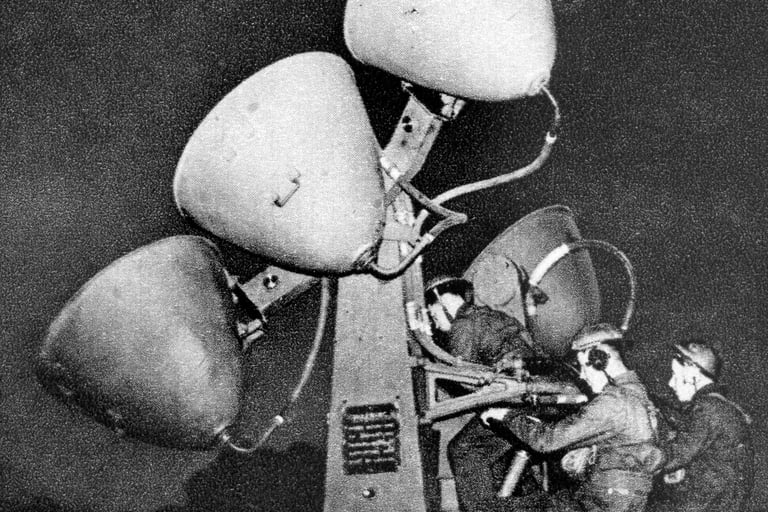Wartime History of Thwing
A look at what was happening in the Thwing area during WW2
FEATUREDTHWINGHISTORY


Wartime Thwing
Part 1: Military Structures in Thwing
Early in 2023, I was asked if I could track down information about a military building that may have been on or near Church Lane in Thwing. I was told it could be related to World War II or possibly WW1 and nothing more.
I set to work getting in touch with various historical groups and contacts and began research on the Internet, all of which proved fruitless. Next, I visited the Treasure House in Beverley where I spoke to an archivist. The very helpful Treasure House team searched the archives for me but none of this took me any further. I still had zero information about any possible military structure. At this point I was ready to give up the search.
Then I unexpectedly received an email from the former Military Support Officer of English Heritage/Historic England who had been informed of my investigation. He told me of a brick structure on Rectory Farm land, Thwing, which he said was listed as a searchlight emplacement. He went on to say, after looking at photographs, he thought the listing was wrong. He didn’t think it was a searchlight because the walls were too high and they would obstruct the light. He thought instead that it was “more likely to be a blast wall that protected a timber high-frequency/ direction finding (HF/DF) tower”. This was quite exciting.
HF/DF towers were used by the RAF to track both enemy and friendly aircraft. They were also used by the Admiralty and GCHQ to monitor radio chatter and track U-boats.
I was sent photos and diagrams of HF/DF towers and blast walls so my next step was to show them to local residents to see if they rang any bells. The first person I showed them to was Mike Burdass and what he told me was pure gold.
He thought the structure was a searchlight emplacement as he remembered seeing a searchlight beam emanating from the area. He also went on to tell me of an anti-aircraft gun that would have been visible from Church Lane. In the company of searchlights it was not uncommon to find one, two or even three anti-aircraft light machine guns (AALMG).
The photo above, is from the Roger J C Thomas Collection and was taken by Mr D Holmes at Folkestone, in 1940. It shows a Lewis Light machine-gun. The Lewis was the most commonly used AALMG and it is likely that it was a Lewis in the field to the side of Church Lane. However, Bren, Vickers K, and Browning guns were also used.
I relayed Mike’s information to my English Heritage contact. He still thought, even with the searchlight evidence, that the brick construction was more likely to be an HF/DF tower and went on to say it was not uncommon for a searchlight to be located by the towers. He also said the only way to be sure would be for him to see the floor of the construction which would have features allowing him to identify its use.
Do you remember seeing a wooden tower, which would have been visible from the Wold Newton road, and possibly from Church Lane? Do you have any further information about military activity and buildings in Thwing? If so please get in touch.
Mike continued to tell me stories of wartime Thwing such as the Church Reading Room being used by the Home Guard and an incendiary bomb that came through the church roof leaving scorch marks behind that are still visible today.
Wartime Thwing Part 2
Since writing about Thwing’s military structures in the May issue of the EastWolds Community Newsletter, a few more things have come to light. Although my sources do not wish to be named, what they had to say is very interesting.
The Rectory Farm brick structure which I talked about turns out to be neither a searchlight enclosure nor protection for an HF/DF tower. Instead, according to a local eyewitness, it was home to a Mk V Sound Locator. (see photo) These pre-radar devices were used to listen for enemy planes by means of an array of upside-down bell-like cones pointed skywards. These would capture the hum of enemy aeroplane engines, concentrating and funnelling the sound to the operator’s headphones, a bit like a giant stethoscope with multiple bells. By moving the array, the operator could pinpoint the direction the planes were coming from and alert the gunners and searchlight operators.
The first use of this type of equipment was claimed by Commander Alfred Rawlinson of the Royal Naval Volunteer Reserve, who in the autumn of 1916 was commanding a mobile anti-aircraft battery on the east coast of England. He needed a means of locating Zeppelins during cloudy conditions and improvised an apparatus from a pair of gramophone horns mounted on a rotating pole. Several of these locators were able to give a fix on the approaching airships, allowing the guns to be directed at them despite their being out of sight.
Photograph of a Mk V Sound Locator
The person who sent in this photograph thought it was copyright of the Imperial War Museum, but I have been in touch with the museum, and they could not find it on their database. They said to carry on and use it in the newsletter. If you know anything more about the photograph, please get in touch.
Sound Locators came in many different shapes and sizes, from what looked like large metal ears strapped to an operator’s head through to the enormous “war tubas”. The Thwing sound locator had four sound cones and two seated operators. The whole thing was moveable. What made Thwing’s locator different was the protective brick wall. Normally protection was provided by sandbags. During the later years of World War 2, the Thwing sound locator was moved from its protective enclosure to a position in the field behind the Old Chapel.
Pushing for greater range, sound locator technology evolved into static concrete sound locators, known as “acoustic mirrors”. Radar, which can tell an object’s location and speed, by analysing bounced radio waves, was soon to make acoustic sound locators defunct.
I have gathered so much information about the war years in Thwing that I will be including it in the next edition of the newsletter, as part three of this article. Does anyone have wartime stories to share about what was happening in their village?
Wartime Thwing Part 3
Just a little more about wartime in this part of the country.
Tanks
The Wolds were very important for tanks. It was the 11th Armoured Division, with its HQ at Duncombe Park, Helmsley, that used this area of the Wolds as a training ground. Later in the war, the Free French armoured units also used the Wolds for training. Hedges were destroyed and livestock moved out of the area. Local residents were regularly asked to stay indoors to avoid getting in the way of tank manoeuvres.
There are still marks left on the landscape from all the activity. To the side of Thwing Mere is a reinforced concrete track which was laid in just half a day and put there to make it easier for tanks to get up and down the short steep bank.
On the side of Thwing Road (B1253) just before Rudston you will find what appears to be a large concrete layby. This was again built for the tanks. If you look closely at this hard standing you will find a couple of rectangular areas that have been infilled. These were inspection pits used by engineers when doing tank servicing and maintenance.
During the ‘invasion-period’ of 1940-41, hard standings were laid for reserves of tanks, held in readiness for attack. Do you know where any of these hard standings are? Or do you know of any other tank tracks that were built in this area or close by?
Halifax Bomber
In March 1942 a Halifax bomber crashed near Thwing Mere. The log says, “Took off 2159 12 Mar 1942 from Middleton-St.George but collided with a dispersal platform losing part of the undercarriage.” There are conflicting reports about this incident. A few put the date as 12th/13th April 1942 rather than March. It does appear that the plane was part of 76 Squadron leaving on an operation flight attacking Essen in Germany. Although yet another report says the destination was unknown. Because of the damage sustained on take-off the bombs, according to one source, were jettisoned at sea. The crew then circled to use up fuel before bailing out near Hunmanby.
The whole story is a bit muddled but it is a fact that the Halifax II went on to crash on a Roman site at Thwing.
In September 2003, at the Thwing Roman site, the ‘Thwing Cylindrical Artefact’ was found. After much deliberation and testing it was found not to be Roman in origin, as first postulated, but a part of the aeroplane that had crashed there in 1942.
Bomb in a Chamber Pot
While talking to various people about wartime Thwing, I learned that an incendiary bomb had come through the roof of a cottage. The occupant gathered up the unexploded bomb in a chamber pot, and threw it out of the window. What makes the story more appealing is the fact that this cottage is where my wife and I now live.




